The warm Pacific breeze touches the shores of Hawaii, bringing out a tasty treasure from the blue waters. The ono fish, also called the wahoo, is a beloved seafood in Hawaiian dishes for centuries. Its firm, tasty meat and bright color make it a favorite, holding a special place in Hawaiian food culture.
If you love seafood or are just curious, trying ono fish is a must. It’s packed with protein and omega-3s, making it good for you and delicious. When summer and fall come, the fish is at its best. This is your chance to enjoy this special Hawaiian treat during the busy tourist season.
Table of contents
Understanding the Pacific Powerhouse Predator
The Pacific ono, also known as the wahoo, is a remarkable warm-water fish. It reigns supreme in the ocean’s blue waters. This game fish is known for its impressive speed and agility, making it a true marvel of nature.
Scientific Classification and Origins
The Pacific ono, or Acanthocybium solandri, belongs to the Scombridae family. This family includes other swift-swimming predators like tuna and mackerel. Native to tropical and subtropical waters, the ono can be found throughout the Atlantic, Indian, and Pacific Oceans.
Physical Characteristics and Features
The Pacific ono has a streamlined, torpedo-shaped body and sharp teeth. It is designed for speed and predatory prowess. These game fish can grow up to 8 feet in length and weigh between 20 to 100 pounds. They are a formidable adversary for any angler.
Natural Habitat Distribution
The Pacific ono thrives in waters with temperatures ranging from 68°F to 80°F. They are found at depths of 0 to 100 meters. Their wide-ranging habitat across the world’s oceans allows them to thrive in diverse marine ecosystems.
| Characteristic | Statistic |
|---|---|
| Maximum Size | 98 inches |
| Usual Size Range | 40 to 65 inches |
| Typical Weight | 30 to 40 pounds |
| Swimming Speed | up to 48 mph |
| Spawning Capacity | 0.5 to 45 million eggs annually |
| Lifespan | 5 to 6 years |
| Preferred Temperature Range | 24°C to 28°C |
| Depth Range | 0 to 1,000 feet |
With their impressive size, speed, and longevity, the Pacific ono are truly remarkable Pacific ono, warm-water fish, and game fish. They captivate anglers and marine enthusiasts alike.
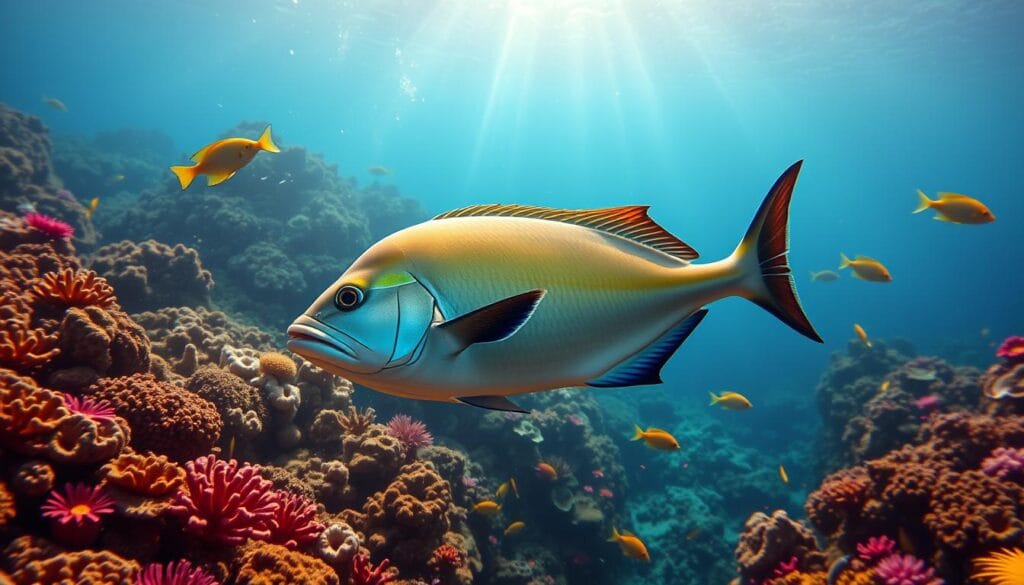
The Cultural Significance of Ono Fish in Hawaiian Heritage
Ono fish, known as the “delicious” fish in Hawaiian, is deeply valued in Hawaiian culture. It has been a key part of Hawaiian food for centuries. This connects islanders to their long history.
The Hawaiian language has 5 vowels and 8 consonants. It includes special symbols like the ‘okina and kahakō. These symbols are key to understanding Hawaiian words.
Ono fish, along with seafood like ahi tuna, shapes Hawaiian cuisine. It’s a favorite at traditional luau feasts and everyday meals. Its versatility makes it a beloved part of Hawaiian food.
Catching fish is seen as a sign of good luck and prosperity. This shows Hawaiians’ deep connection to their natural world and marine resources.
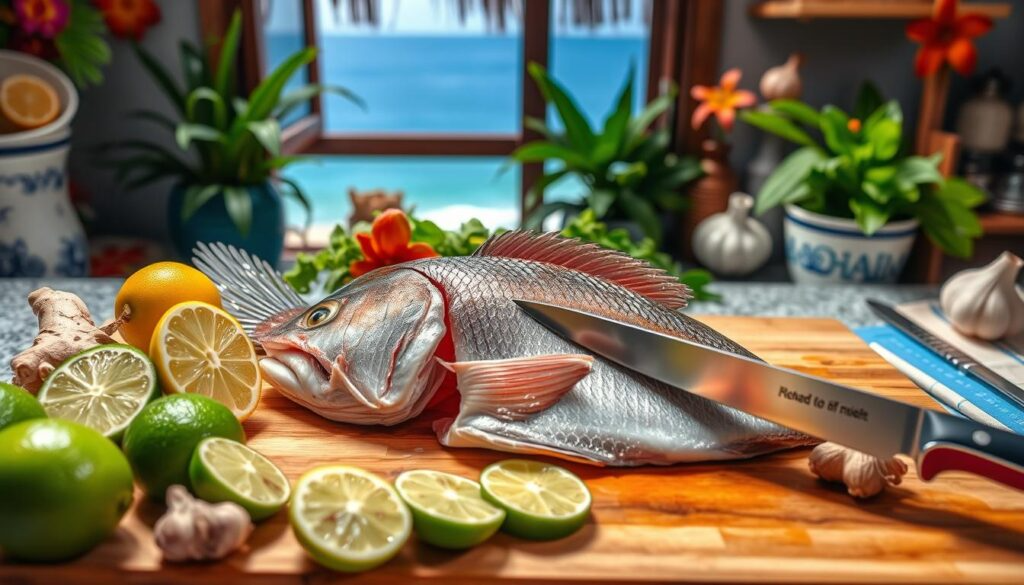
In recent years, Hawaiians have worked to keep their culture alive. This includes celebrating ono fish’s importance. Through songs, dances, educational programs, and museum exhibits, Hawaiians honor this seafood delicacy’s legacy.
Identifying Premium Ono Fish: Selection Guide
Choosing ono fish, also known as Hawaiian ono, requires a keen eye and a love for quality. This seafood delicacy is prized for its firm flesh and bright color. These signs indicate its freshness and great taste.
Fresh vs Frozen Options
Fresh ono fish is preferred over frozen. It has a better texture and taste, capturing the Pacific’s essence. Fresh ono is available from June to October, with the best months being summer and fall.
Quality Indicators to Look For
- Firm, clear flesh with a bright, vibrant hue
- A fresh, ocean-like aroma without any unpleasant fishy odors
- Clear, shiny eyes and red, robust gills
Seasonal Availability
The best ono fish is available from June to October. This is when Hawaii’s waters are perfect for the fish’s growth and taste.
| Grade | Characteristics | Ideal Uses |
|---|---|---|
| Grade A Uni | Vibrant color, smooth texture, clean, sweet taste | Sushi, sashimi |
| Grade B Uni | Muted color, slightly less smooth texture | Pasta, risotto |
| Grade C Uni | Less visually appealing, but suitable for cooking | Sauces, dips |
Knowing the quality signs and when ono fish is in season helps. This way, you can pick the best and most flavorful fish to enjoy its true taste.
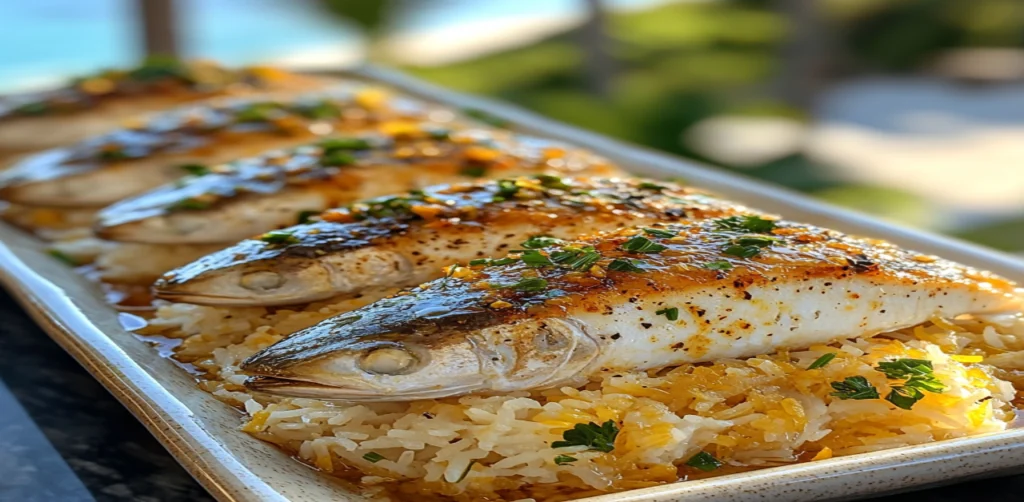
Nutritional Benefits and Health Properties
Ono fish, also known as wahoo, is a seafood delicacy loved for its flavor and nutritional value. It’s a Pacific predator that’s a nutritional superstar. It offers many health benefits for your well-being.
fish is high in protein. A 3-ounce serving of grilled ono has about 20 grams of protein. This makes it great for muscle growth and maintenance. It’s also low in calories and saturated fats, so you can enjoy it without worrying about your diet.
This fish is also rich in omega-3 fatty acids. Each 100-gram serving has about 1.5 grams. Omega-3s are good for your heart, reducing the risk of heart disease and stroke. They also have anti-inflammatory properties, making ono a great addition to a healthy diet.
Ono fish is a good source of selenium, an antioxidant that protects cells. It also has vitamins B6, B12, and niacin. These vitamins help keep your brain working well, boost energy, and support overall health.
“Ono fish is a nutritional powerhouse, offering a unique blend of high-quality protein, heart-healthy omega-3s, and essential vitamins and minerals.”
If you want to support muscle recovery, improve heart health, or just enjoy a tasty and healthy seafood option, ono is a great choice. Adding this Pacific predator to your diet can greatly benefit your overall wellness.

Essential Preparation Techniques for Ono Fish
Working with ono fish, also known as wahoo, needs careful steps to keep its flavor and texture right. Whether you’re a pro chef or a home cook, learning to clean, fillet, and store this Hawaiian cuisine gem will make your seafood dishes stand out.
Cleaning and Filleting Methods
First, rinse the ono fish well under cold water. Then, use a sharp knife to remove the skin and any bones. Be careful of the sharp teeth. Cut the fillets into portions you like, making sure they’re even for the best look and cooking.
Marination Tips
To boost the ono fish’s flavor, marinate the fillets. Mix citrus juices, fresh herbs, or tropical flavors. A mix of lime juice, cilantro, and honey is great. Let the fillets marinate for 30 minutes to an hour before cooking.
Storage Guidelines
Keep fresh fish in the fridge and use it within 1-2 days. For longer storage, wrap the fillets in plastic wrap or freeze in an airtight container for up to 6 months. Thaw the fish in the fridge overnight before cooking.
Mastering these steps will help you bring out the best in ono fish. You’ll be able to make delicious Hawaiian cuisine dishes that showcase the Pacific Ocean’s bounty.

Popular Cooking Methods and Recipes
Hawaiian cuisine highlights the ono as a seafood gem. This Pacific predator is versatile, with a firm texture and mild, sweet taste. It’s great for grilling, pan-searing, and more, loved by chefs and home cooks alike.
Grilling fish with tropical salsa is a hit. It combines smoky flavors with fresh tastes. Ono tacos are also popular, with the fish battered and fried, served in warm tortillas with cabbage, pico de gallo, and creamy sauce.
Try ono ceviche for a refreshing dish. The fish is marinated in citrus, mixed with onions, cilantro, mango, or avocado. Pan-searing with butter sauce also brings out the fish’s tender texture.
The fish shines in Hawaiian cuisine, thanks to its versatility. Its firm flesh and mild flavor pair well with many seasonings and sauces. This ensures a delicious meal every time.
“The ono fish is a true gem of the Hawaiian islands, with a flavor profile that’s both delicate and dynamic. Its culinary versatility makes it a must-try for any seafood enthusiast.”
Sustainable Fishing Practices and Conservation
The Pacific ono, a prized game fish, is found in Hawaii’s waters. It’s important to keep fishing practices sustainable for its future. Even though the ono is not endangered now, we must protect it for the next generations.
Current Population Status
The ono, also known as the wahoo, migrates across the Pacific. In Hawaii, its population is stable thanks to fishing rules. These rules help young fish grow and reproduce, keeping the stock healthy.
Environmental Concerns
The Pacific ono faces many environmental threats. Overfishing, habitat loss, and climate change are big concerns. To tackle these, conservation efforts are underway, including:
- Creating Marine Protected Areas (MPAs) to protect habitats
- Using selective fishing gear to reduce bycatch
- Working with local communities for better management
- Supporting sustainable aquaculture and reef restoration
Together, the fishing industry, conservation groups, and local communities can protect the Pacific ono in Hawaii’s waters.
| Sustainable Fishing Practices | Benefits |
|---|---|
| Size and catch limits | Protect juvenile fish and allow for replenishment of stocks |
| Selective fishing gear | Reduce bycatch and protect endangered species |
| Marine Protected Areas (MPAs) | Safeguard critical habitats and allow marine life to thrive |
| Community-based management | Integrate traditional ecological knowledge with modern practices |
| Sustainable aquaculture and reef restoration | Supplement wild populations and enhance ecosystem resilience |
By adopting sustainable fishing and conservation, we can keep the Pacific ono abundant in Hawaii’s waters. It’s a true treasure of our marine ecosystem.
Best Fishing Locations and Seasons in Hawaii
Hawaii’s waters are perfect for catching the Hawaiian ono, a fast and strong game fish. The ono, or wahoo, is a top catch for both fun and professional fishing. It’s known for its speed and fight.
The best spots for ono fishing are around Oahu, Maui, and Kauai. These places are known for lots of ono, especially from June to October. This is when ono are most active and plentiful.
Anglers use fast trolling and casting to catch ono in Hawaii. The best times are early morning and late afternoon. This is when ono usually hunt. Anglers also use chumming and live bait to attract them.
| Fishing Location | Best Season | Preferred Water Temperature | Average Weight of Ono |
|---|---|---|---|
| Oahu, Maui, Kauai | June to October | 70-88°F | 8-30 lbs |
Aside from ono, Hawaii has many other game fish like shibi, mahi, and kawakawa. With its beautiful landscapes and rich marine life, Hawaii is a top spot for fishing. It’s great for both new and experienced anglers.
“The ono is a true ocean predator, with the speed and power to challenge even the most experienced fisherman. Catching one in the vibrant waters of Hawaii is a true highlight of any angling adventure.”
Traditional Hawaiian Ono Fish Dishes
The Hawaiian islands are famous for their tasty food, with fish being a key ingredient. This fish is loved for its many uses, showing the islands’ rich food history.
Poke is a famous dish made with raw fish. It’s mixed with soy sauce, sesame oil, and macadamia nuts. People love it as a snack or appetizer.
Grilled ono with tropical fruits is another favorite. The fish is paired with pineapple, mango, and papaya. This mix of sweet and savory is a true celebration of the islands’ produce.
Ono sashimi is also popular, showing off the fish’s fresh taste. It’s served with pickled ginger and wasabi. This lets the fish’s natural flavors shine.
fish stews, called lau lau, are great for cozy meals. They simmer ono in taro leaves, making a flavorful and comforting dish.
Ono fish’s versatility shows the creativity of Hawaiian cooks. From poke to grilled ono with tropical fruits, these dishes highlight Hawaiian cuisine and the role of fish in it.
The Commercial Value of Ono Fish
Ono fish is a prized ocean delicacy with great commercial value in Hawaii and beyond. Its exceptional taste and premium quality make it highly sought after. This demand drives up prices in restaurants, markets, and among discerning consumers.
The commercial fishing industry, including charter fishing businesses, benefits greatly from ono’s reputation. It is seen as an exclusive and desirable game fish.
Market Demand
Ono fish is a top choice for high-end seafood establishments. It offers a distinctive and exceptional dining experience. With its delicious meat and impressive size, ono can fetch premium prices, ranging from $15 to $30 per pound in the United States.
This exclusivity has cemented ono’s status as a coveted seafood delicacy. It is a favorite among chefs and seafood enthusiasts alike.
Economic Impact
The commercial value of ono fish has a substantial impact on Hawaii’s local economy. The ono fishing industry, which includes commercial fishermen, seafood retailers, and the tourism sector, generates significant revenue for the state.
Ono’s popularity as a game fish also supports charter fishing businesses. This further contributes to the economic benefits of this prized ocean predator.
Ono fish can grow up to 8 feet in length and weigh up to 100 pounds. They have an average lifespan of 4 to 5 years. This makes them a valuable catch for the commercial fishing industry.
The economic impact of the ono fish industry shows the appreciation and value placed on this exceptional ono fish and seafood delicacy in Hawaii and beyond.
Pairing and Serving Suggestions
Enjoying Hawaiian cuisine means trying the ono fish, a seafood gem. It’s a Pacific predator with a firm, flaky texture and a mild, sweet taste. It pairs well with light, tropical flavors.
For a memorable meal, serve grilled ono fish with pineapple salsa or mango chutney. These sweet flavors balance the ono’s taste, making a perfect tropical mix.
Pair the ono with a crisp white wine like Sauvignon Blanc or Pinot Grigio. These wines cut through the fish’s richness, making the meal delightful.
Ono fish also goes well with Hawaiian sides like coconut rice, roasted veggies, or a green salad. These dishes enhance the ono’s flavor and make the plate look great.
| Serving Size | Prep Time | Cook Time | Total Time |
|---|---|---|---|
| 4 servings | 5 minutes | 15 minutes | 20 minutes |
Adding ono fish to your menu is a great way to impress at a dinner party or enjoy Hawaiian flavors at home. It’s a sure way to please your guests and take them to the Pacific’s sunny shores.
Conclusion: Embracing Hawaii’s Ocean Delicacy
The fish, also known as the wahoo, is a treasure in Hawaii’s food and culture. It adds variety to Hawaiian dishes and helps local fishermen. This fish shows the islands’ vast marine life.
Trying ono fish, you’ll see its special bond with Hawaii. It’s great grilled, sautéed, or raw. Its taste and texture bring you into Hawaii’s lively food world, where the sea’s gifts are honored.
Supporting fish and eco-friendly fishing helps save this species for the future. Enjoying its taste, learning about its culture, and connecting with local fishermen lets you truly feel Hawaii’s ocean gift. This way, you’ll not only enjoy great food but also help protect Hawaii’s seas and heritage.
FAQ
What is ono fish?
Ono fish, also known as wahoo, is a prized Hawaiian delicacy. It’s found in the warm Pacific Ocean. It’s known for its sweet flavor, vibrant flesh, and firm texture.
What are the physical characteristics of ono fish?
Ono fish (Acanthocybium solandri) belongs to the Scombridae family. It has a streamlined, torpedo-shaped body with sharp teeth. Ono can reach up to 8 feet in length and weigh between 20 to 100 pounds.
Where does ono fish thrive?
Ono fish thrives in tropical and subtropical waters. It’s found in the Atlantic, Indian, and Pacific Oceans. It prefers temperatures between 68°F and 80°F at depths of 0 to 100 meters.
What is the cultural significance of ono fish in Hawaii?
Ono fish is very important in Hawaiian culture and cuisine. Its name means “delicious” in Hawaiian. It’s seen as a symbol of good luck and prosperity for those who catch it.
When is ono fish available in Hawaii?
Ono fish is available from June to October. The peak flavor is during summer and fall months.
How do you identify high-quality ono fish?
Look for firm, clear flesh with a bright appearance when selecting ono fish. Quality indicators include a fresh ocean smell, clear eyes, and red gills.
What are the nutritional benefits of ono fish?
Ono fish is a nutritional powerhouse. It’s high in lean protein and omega-3 fatty acids. It’s also a good source of vitamins B6, B12, niacin, and selenium, supporting muscle growth, heart health, and brain function.
How do you prepare and cook ono fish?
To prepare ono fish, clean and fillet it carefully, removing any bones. Marinate with citrus, herbs, or tropical flavors to enhance its taste. Popular cooking methods include grilling, pan-frying, baking, and serving raw as sashimi.
What are the conservation efforts for ono fish?
While ono fish is not currently listed as endangered, sustainable fishing practices are crucial. Conservation efforts include implementing size and catch limits, protecting critical habitats, and raising public awareness about sustainable fishing practices.
Where are the best ono fishing locations in Hawaii?
Prime ono fishing locations in Hawaii include waters surrounding Oahu, Maui, and Kauai. The best season for ono fishing is from June to October when the fish are most abundant.
What are some traditional Hawaiian ono fish dishes?
Traditional Hawaiian ono fish dishes showcase the versatility of this prized catch. Popular preparations include poke (raw fish salad), grilled ono with tropical fruits, ono sashimi, and ono fish stews.
What is the commercial value of ono fish?
Ono fish holds significant commercial value in Hawaii and beyond. Its popularity in restaurants and markets drives demand, contributing to local economies. The fishing industry, including charter fishing businesses, benefits from ono’s reputation as a prized game fish and delicacy.
A Note from the Chef
We hope you enjoy making it as much as we enjoyed writing it.

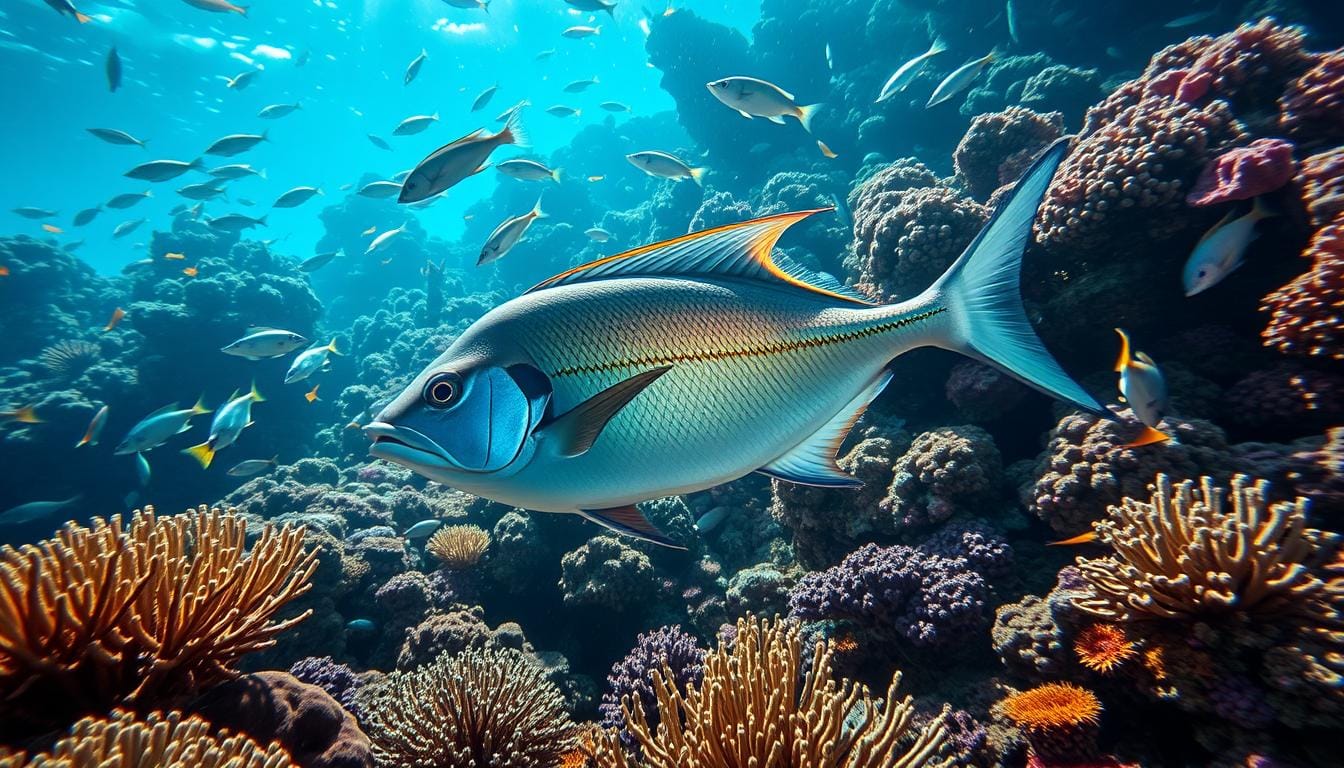


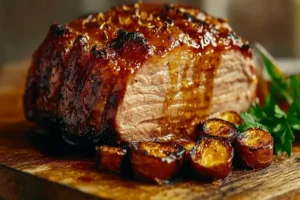
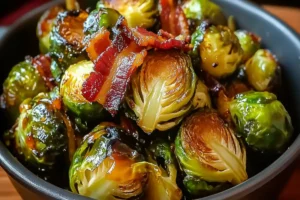

1 thought on “Delicious Ono Fish: Hawaii’s Prized Ocean Delicacy”